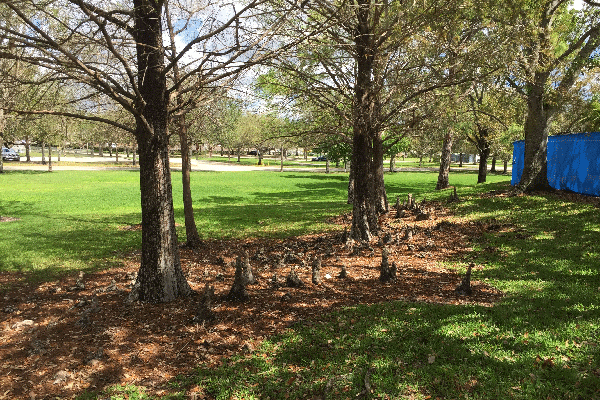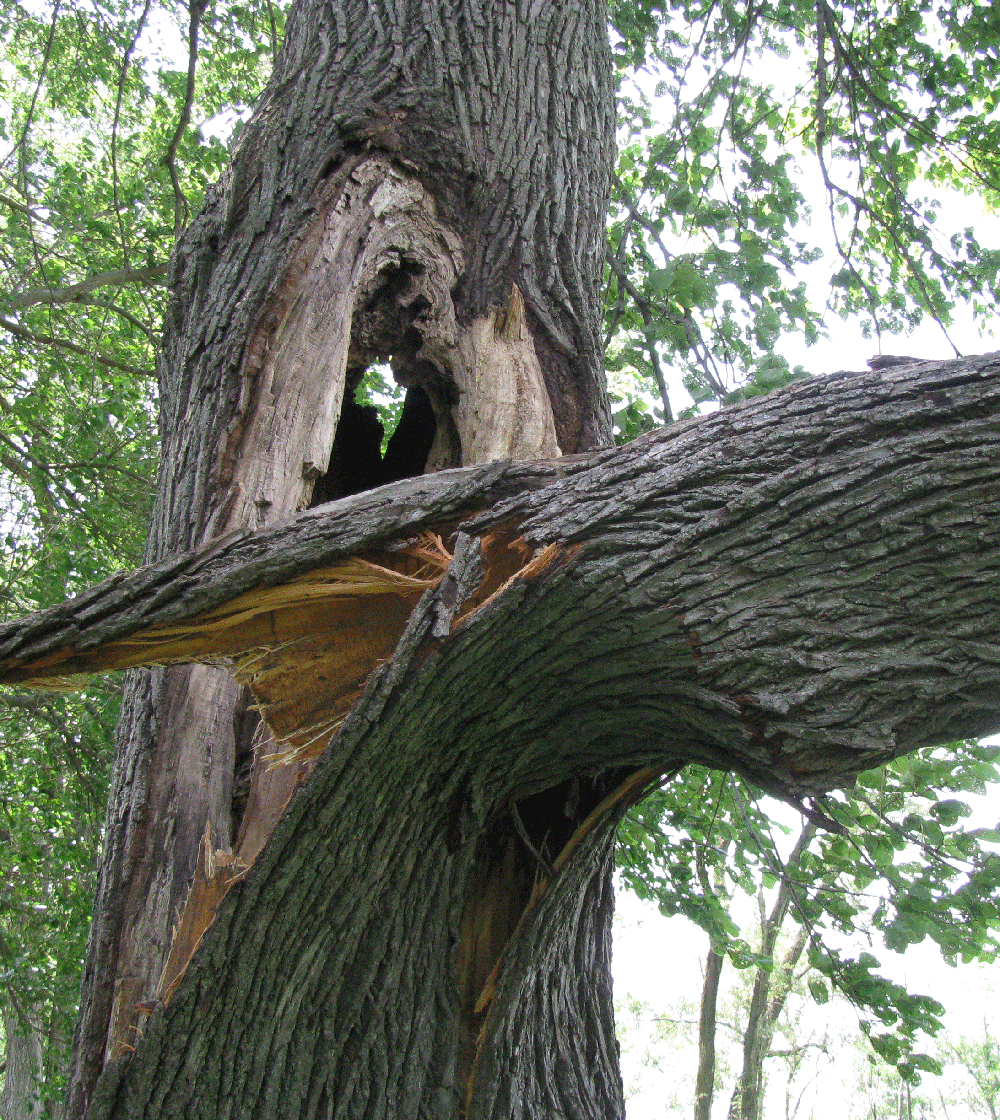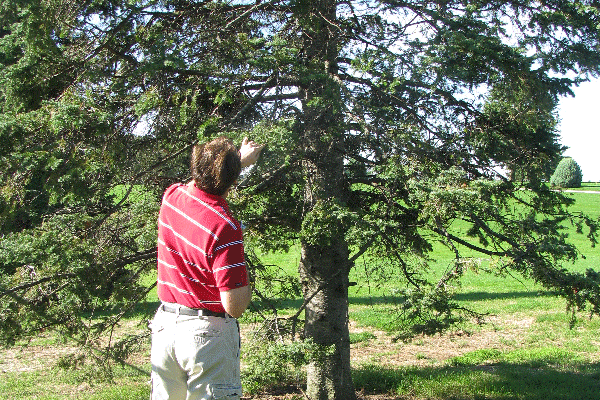The title might be a bit shocking, especially considering the author is an arborist and horticulturist, but it’s always wise to look at all sides of anything that we spend time with - from equipment, to pests, to the trees in the landscape. The theme here is that without a doubt, there are issues with the woody plants intermingled with turf, gardens and groundcovers, and taking a closer look at the negative aspects of trees in the context of the overall landscape will pay dividends of healthier plants, lowered maintenance costs, greater alignment with the original landscape plan, and retention of well-placed, good condition trees.
Keep in Mind
Judicious tree removal or modification is a process; as it unfolds, it’s prudent to keep in mind that some specimens are historic or memorial trees, sometimes with baggage or property specific information associated with them.
 Baldcypress "knees".
Baldcypress "knees". Three tenets help guide the process. First, what is or was the original/intended purpose of the tree? Was it planted because it was, A. free, B. pretty or C. served a functional purpose such as screening an unattractive view?
Second, the premise of Right Tree, Right Place (RTRP). Placement is a really important factor in the process. For example, a baldcypress is a species that is adapted to wet and dry sites, has attractive foliage and few pest problems. However, it has an extensive root system, often referred to as “knees” that protrude 1-2 feet above ground; a great choice for the edge of a lawn, not so good for high traffic sites.
Third, both in terms of choosing good candidates for removals and (if appropriate) replacement, paying attention to the 10% rule (no more than 10% of a given tree species in a community) will promote diversity and greater resistance to pests.
Classic Guidance Model
In addition to the tenets above, a classic guidance model adapted with extensive input from Steve Rodie, ASLA, is very helpful in terms of removal and replacement options. The following 7-step circular approach is thorough, allowing for input from sources that may not have been immediately apparent. If it looks or sounds vaguely familiar, it’s likely that you may have utilized parts of it as you processed the loss of a loved one, a house fire, totaling your car, being robbed or moving your parents into assisted living. The main action is first, followed by typical examples of specific situations.
- Accept the situation – it is what it is; i.e. it’s here, in poor condition, casting heavy shade on the veggie garden.
- Analyze facts and feelings – the turf is thinning, visitors are tripping on the surface roots of the tree, we’re getting lots of complaints from neighbors.
- Define goals and objectives – create and maintain a healthy and functional landscape, renovate and make changes as necessary.
- Generate ideas to achieve goals and objectives – for example, remove 3 trees by the back gate, then install understory shrubs and reseed.
- Select the best ideas or combination of ideas – could be based on family input and suggestions by neighbors.
- Implement proposed actions – usually best in a step by step approach.
- Evaluate the performance or result of implementation, then go back to step 1 and start again.
Benefits of Trees
Before going totally rogue and endorsing wholesale cutting of every woody plant, it’s sensible to remind ourselves of the many benefits of trees. In addition to the environmental impacts of oxygen production, carbon sequestration, cooling effects, energy cost reductions and crime discouragement, trees can solve many landscape problems and provide significant amenity.
The screening of undesirable views and definition of property lines is a significant benefit. Backdrop and framing trees can provide assistance in gaining depth perception, while the shade from a deciduous tree can provide tremendous value for patio inhabitants and children seeking a relief from blazing hot conditions. Of course, some trees provide edible fruit for both humans and wildlife and can be worthy of retention for this factor. However, the list of possible problems with trees is quite long.
Problems with Trees
However, potential problems with trees on a property, or any landscape setting for that matter, are many and varied. Without a doubt, shading is first on the minds of many property owners. Less than adequate quantity and quality sunlight reduces root growth as the energy goes into the production of plant leaves to gain badly needed photosynthetic surface, produces thinner cell walls and increased leaf elongation, reduced tillering and increased relative humidity due to reduced air movement over the plant surface. Competition with tree roots for water and nutrients is troublesome as well.
The reduction or lack of necessary sunlight is not the only problem by any means; all the others are just as big of a concern, even though shade is so obvious.
At least 9 other factors associated with woody plants are problematic, some more than others, but all should be dealt with under the classic guidance model. First, debris on the traffic or recreational surface. Some trees such as sycamore, birch, oak, crabapple and maple drop chunks of bark, fruit, bud scales, flowers and leaves causing a disruption in usage. Naturally, some times of year are worse than others, such as fall with needles from evergreens and seeds of broadleaves in spring and summer, but others drop leaves almost continuously throughout the year. All of this material must be dealt with in some way, either with blowing, mowing or sweeping, which takes time and effort.
A quite serious concern is the potential litigation from structurally weak trees, especially ones in target zones such as the house, storage shed, carport, driveway and other areas of frequent human occupancy. Regular inspection is required to lessen the liability of the owner from unwanted injuries and damage. Additionally, cleanup of debris and fallen branches following wind storms and snow events consumes time as well as creates the need to process the woody material in some way, usually through grinding and composting for later use or outright disposal. As well, in addition to the above ground parts of trees that drop onto the turf, the roots often become a problem, causing damage to sidewalks and intrusion into recreational surfaces, requiring intervention.
Trees require pest control, just like turf, vegetable plants and small fruits. As such, it’s wise to lean on integrated pest management principles including using disease resistant cultivars and proper spacing in order to keep them at bay. A big issue are the “super pests” such as pine wilt, thousand cankers disease, Asian longhorn beetles, Japanese beetles and emerald ash borer that can cause major damage in a short period of time.
In the Long Run
These issues underscore the need to get it right in the first place, from the start. The principles of proper placement, appropriate locations, the separation of trees and turf and performing initial pruning to prevent defects will eliminate many if not most of the problems that arise.
The problems outlined in the previous section draw attention to the importance of selection for shape, size, debris production, pest resistance, desirable aesthetic attributes i.e. fall color, spring flowers, glossy leaves, habitat for songbirds and functional features such as screening. If these specifics are considered in conjunction with the 10% guideline to ensure diversity of species, minimal conflicts will occur.
In order to maximize high value persistence in the landscape, it’s essential to identify the need for and adhere to the implementation of routine inspection and ongoing monitoring. Pests, structural problems and interactions with maintenance inputs are not to be ignored. Regular maintenance and best management practices for trees (mulching, watering, removal of broken limbs, etc.) will also minimize problems and maximize their value.
Also in the long run, a reflection on Right Tree, Right Place, at least from time to time is truly worthy. From time to time, as issues arise, asking the question – would a smaller tree or even a shrub have been a better choice? – will yield positive outcomes. This sort of introspection is helpful, especially when initial selection may have been hurried.
Removal or Thinning/Pruning
The title of this article encourages action to rid landscapes of the negatives of poorly placed, maintained or chosen trees. Unfortunately, when you get right down to it, there really aren’t too many options other than prevention – just pruning or removal. The answer to the question whether to cut at the base or in the canopy is…it depends. If you’re fortunate to have an attorney in your family, the answer to most of your legal questions is likely to be “it depends”, as the jurisdiction, the judge, the jury, the voir dire, the pre-trial motions, the defendants legal history, etc. all affect the answer.
For the purposes of this choice, a couple of initial considerations are pertinent. First, if only one tree is casting excessive shade on an area and dropping excessive debris, a reasonable option would be to strategically remove certain branches to allow greater sunlight penetration and reduce the debris issues. However, if several trees are problematic in a specific location, removal is likely the better choice. Secondly, the original purpose of the tree should always be considered.
Unfortunately, neither is without negative consequences. Removal of a tree and its associated benefits requires an outlay of resources, often brings complaints from family members and disrupts outdoor activities while being removed. Pruning can have even more undesirable outcomes, ones that are often not expected.
 Heartwood decay, resulting in tree failure.
Heartwood decay, resulting in tree failure. Negative Consequences of Pruning
The most dramatic result of pruning limbs is the opening up of the heartwood to decay invasion. Small cuts, made early in the trees’ life usually close over with minimal infection from pathogens. However, if the diameter is more than 3-4 inches, decay is inevitable, especially on tree species that don’t close wounds readily such as silver maple. Black locust and osage orange are species that are quite decay resistant, allowing for greater opportunity for pruning options.
Many other negative consequences exist result from pruning mature trees. One significant outcome is that it removes photosynthetic surfaces from the tree, causing it to go into a mode where it uses reserves that are intended for defense against insects and for survival during drought. Once the limbs have been removed, the canopy is exposed to greater sunlight penetration on bark that was previously shaded to a greater level of sunlight, thereby increasing the potential for sunscald and other bark injury.
Another unwanted result is that the pruning cuts remove the branch terminals and apical meristems, removing the growth regulators that have had dominance over the embedded buds in the trunk and branches that remain in the tree after limb removal. Once they’re gone, the otherwise suppressed buds are free to grow and start producing suckers that are weakly attached to the limbs. In fact, they are only attached in the outer ring of the scaffold branches, in the newest sapwood, not deep into the heartwood like the removed portions of the tree. As well, as the suckers grow, they will produce their own shade, until they break off in wind and snow storms, creating more debris below.
The list of negatives continues as in order to create enough sunlight for the understory plants to be significantly improved, a large number of limbs need to be removed, usually 40 to 50% of the canopy. Due to the regrowth potential of deciduous trees, the procedure has to be repeated every few years or so, creating the need to remove and process all of the wood waste, not to mention the actual costs of hiring an arborist to do the pruning and additional injury to the tree.
As well, if the pruning is not done correctly, such as when only the lower limbs are removed, a strong lever is created, making the tree more susceptible to wind throw and catastrophic failure. Finally, the concept of thinning and the physics of resistance to excessive wind are juxtaposed to each other, in that the greater the number of limbs that are removed from the center of the canopy, the more likely the tree is to fail, as the potential for the canopy to diffuse the forces is reduced; instead of decreasing the energy, the wind has a greater capacity to penetrate and exert force on the tree as it moves through it.
If, however, there are several trees, the best way to improve conditions sufficiently is to remove at least some of them. Which ones? Well, in the short run….
In the Short Run
It’s best to begin by identifying a registered consulting arborist or an ISA Certified Arborist, preferably with TRAQ (Tree Risk Assessment Qualification) credentials to evaluate the status of each tree using a systematic method. Such a process usually involves 5 steps:
- Start with historically problematic trees and slate them for initial action.
- Prioritize by use area i.e. patios, driveways, lawns, back alley and make a second pass through the property focusing on purpose, condition and placement.
- Make a third pass through the rest of the property to finish.
- Make a plan to re-visit steps 1, 2 and 3 to identify subsequent changes, which are likely to have occurred in the time that it took to implement steps 1, 2 and 3. This is a key evaluation of implemented actions steps, which is unfortunately often omitted.
- Replace some of the trees that have been removed with purpose, pest resistance, desirable attributes, placement, usage and other benefits in mind. Insist that these new trees are inspected, trained and maintained according to best management practices in order to keep them as an asset rather than a detriment.
Decisions about removal, pruning and replacement are important ones in the overall maintenance of the landscape. Fortunately, property owners don’t have to go it alone as assistance is available from certified arborists and university extension professionals.

